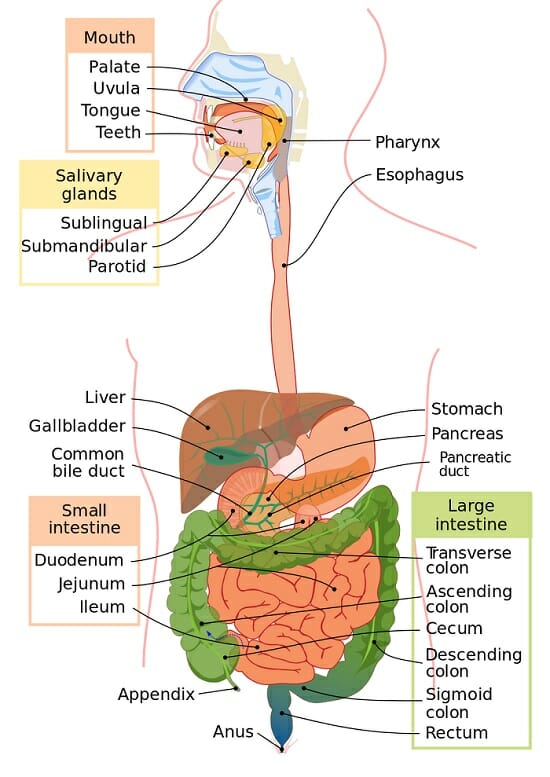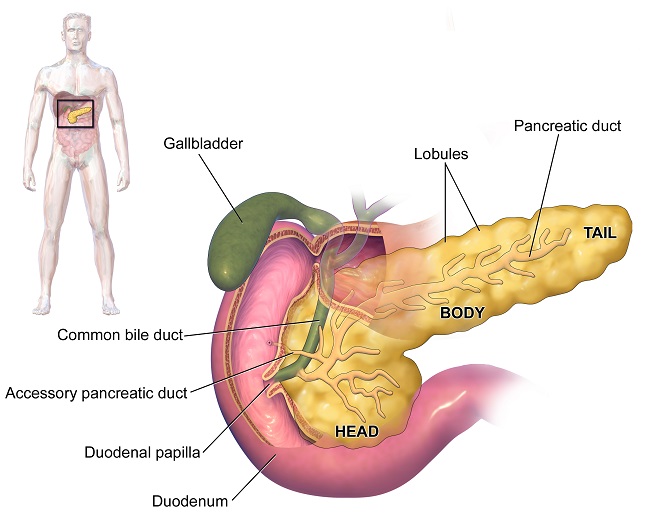A digestive system is a group of organs consisting of the central gastrointestinal (GI) tract and its associated accessory organs that break down food into smaller components so that nutrients can be absorbed and assimilated. This provides the necessary energy to sustain the body.
How Does the Digestive System Work?
The GI tract is a long tube of varying diameter beginning at the mouth and ending in the anus. The glands of the digestive system consist of the tongue, salivary glands, liver, gall bladder, and pancreas. Digestion can be divided into three stages – the oral phase (mouth), the gastric phase (stomach) and the intestinal phase (small intestine)– depending on the position of food within the digestive tract. At each stage, different nutrients are digested, under varying circumstances.
The GI tract begins to form early during the development of the human body, in the third week after fertilization. Around the 16th day of development, the primitive gut is formed through invaginations of embryonic cells. The initial structures of the digestive system extend from the buccopharyngeal membrane to the cloacal membrane. The mouth forms when the buccopharyngeal membrane breaks down and opens the digestive tract to amniotic fluid. For the rest of fetal development, amniotic fluid is actively swallowed.
Digestive System Function
Breaking Down Food
The organs of the digestive system work together so that complex biomolecules in food are broken down into their simple monomers and absorbed by the body. A number of secretions and the activity of a variety of enzymes, starting from the mouth till the intestines, are involved in this process. The internal structure of the different glands and organs of this system reflect their particular roles, such as the stomach containing multiple muscle layers in order to churn and mix food, or the mouth having salivary glands and teeth for grinding and lubrication. Each organ has a distinct pH and a special set of proteins, electrolytes, and enzymes to facilitate their activity. Different parts of the digestive system are also regulated together, depending on the progression of food through the GI tract. Another important function of the digestive system is the removal of undigested food particles through egestion.
The mouth maintains a nearly neutral pH, due to the presence of saliva, though the pH of the mouth can vary temporarily based on the food being ingested. The stomach has the lowest pH in the digestive system, occasionally reaching as low as 1.0. Immediately afterward, though, the enzymes of the small intestine function at a pH between 6.0 and 7.4, resulting in more than a million-fold change in hydrogen ion concentration in the span of a few centimeters. Secretions of the pancreas and liver, consisting of alkaline bile and bicarbonate ions, mediate this remarkable alteration. The separation of the stomach from the small intestine is also maintained by the pyloric sphincter of the stomach – a small band of smooth muscle that acts like a valve, regulating the movement of chyme from the stomach into the intestine and preventing its regurgitation.
Regulating Digestive Secretions
The regulation of digestive secretions can be divided into three phases – the cephalic, the gastric and the intestinal phases. The initial cephalic phase is the secretion of digestive enzymes and secretions at the sight, smell or thought of food. Phrases like ‘mouth-watering’ derive from this phase of digestive regulation, though this stage in regulation affects both salivary glands and the stomach.
The gastric phase of regulation begins when food is swallowed. The stomach immediately begins to prepare to receive food through the esophagus. The intestinal phase is associated with the duodenum and not only influences the release of secretions from the liver and pancreas but also provides feedback to the stomach. This alters secretions from the stomach and digestion activity through neuronal and hormonal mediators.
Digestive System Organs
It is useful to consider the organs of the digestive system from a developmental standpoint. Until birth, the primitive gut is divided into three segments – the foregut, midgut, and hindgut. The foregut comprises the mouth, salivary glands, esophagus, stomach, liver, gall bladder, the superior portion of the pancreas and the initial sections of the duodenum in the small intestine.
The midgut continues from this, consisting of the lower duodenum, jejunum, and ileum of the small intestine. The midgut also includes the cecum, appendix, ascending colon, and parts of the transverse colon in the large intestine. The hindgut contains the last one-third of the transverse colon, the descending colon, and the upper parts of the anal canal. These are all parts of the large intestine. The digestive system has a complex anatomy, so let’s look at each part below.

Mouth and Esophagus
The hard and soft palates form the roof of the mouth and the salivary glands pour their secretions into the mouth during the oral phase of digestion. There are three pairs of major salivary glands, one pair at the floor of the mouth (sublingual glands), another under the tongue (submandibular glands) and the third near the upper teeth (parotid glands). In addition, minor glands in the lips, cheeks, linings of the mouth and throat also help in secreting saliva.
Saliva contains two important enzymes called salivary amylase and lipase that begin the process of digesting carbohydrates and fats in the mouth. Saliva is made mostly of water, has some electrolytes and mucus as well as glycoproteins and antimicrobial agents. It is not only important for lubricating food and making it easy to swallow, but it also helps in maintaining oral hygiene. Dehydration can lead to the formation of viscous saliva (since it is 99.5% water) that is unable to reach the regions between the teeth and keep them healthy.
Teeth help in tearing, biting, chewing and grinding food. Along with saliva, they transform food into a relatively smooth bolus that can be swallowed. The bolus passes through the esophagus, a long and relatively narrow tube made of smooth muscle that traverses the thoracic cavity. It contains two rings of smooth muscle at the top and bottom called the upper and lower esophageal sphincters.
While the upper sphincter is under voluntary control and prevents the passage of food into the respiratory system, the lower esophageal sphincter (LES) is present near the junction with the stomach. When the LES does not close fully, it leads to heartburn or reflux.
Stomach
At the stomach, the diameter of the GI tract increases to form a hollow sac-like structure made of three layers of smooth muscle. These muscles are arranged in longitudinal, diagonal and circular layers. They contract in a coordinated manner to churn the food and mix it with gastric secretions. The mucous membranes of the stomach contain cells that secrete hydrochloric acid (parietal cells) as well as digestive enzymes (chief cells). Enzymes are secreted in an inactive state and become activated in the low pH of the organ.
When the stomach is empty or contracted, the inner surface forms a number of ridges called rugae. These ridges are prominent near the pyloric end of the stomach and disappear when the stomach is distended. The stomach also contains endocrine glands that regulate digestion. The hormones produced by the stomach can either enhance or inhibit its digestive activity and include gastrin, histamine, and somatostatin.
Liver, Gallbladder, and Pancreas
The liver is the heaviest and largest gland in the human body and is formed of four lobes. Liver function plays a serious role in digestion. The liver releases bile secretions which emulsify fats and enhances the activity of pancreatic and intestinal lipases. The alkaline nature of bile also neutralizes gastric acids when chyme enters the duodenum. Bile is necessary for the absorption of vitamin K from the gut.
While some bile can flow directly into the intestine, some of it is stored in the gall bladder and released in response to the ingress of partially digested food from the stomach.
The pancreas is among the most important digestive organs and is located behind the stomach. It secretes a large number of enzymes, involved in the digestion of carbohydrates, fats, and proteins. Its proteases are secreted in their inactive form and initially activated through a membrane-bound enzyme in the duodenum called enteropeptidase. A few molecules of an activated enzyme can then create a cascade of active proteases. The pancreas also secretes amylases that digest carbohydrates, and lipases, phospholipases and cholesterol esterases that are involved in fat digestion and metabolism. Hormones secreted by the stomach as well as the intestine control pancreatic secretions.

Small Intestine
The small intestine is divided into three regions based on their function, even though they are largely similar from a histological standpoint. The first part of the small intestine is called the duodenum and is the shortest segment. It is curved and surrounds one end of the pancreas. It is separated from the stomach by the pyloric sphincter and receives gastric chyme in small quantities when the sphincter opens. The common bile duct and pancreatic ducts open into the duodenum, where the final stages of digestion occur – both due to pancreatic enzymes and membrane-bound intestinal enzymes.
The duodenum also contains glands that produce alkaline secretions that neutralize chyme, along with bile. The second section of the small intestine is called the jejunum and marks the site where absorption of digested nutrients begins. The jejunum contains both villi and microvilli that increase its surface area for absorption. The last segment of the small intestine is the ileum, which is also the longest and can be nearly 3 meters in length. This is the site for the absorption of vitamin B12 and reabsorption of bile salts.

Large Intestine
The large intestine consisting of the cecum, colon and rectum function as the sites for water absorption, and the compaction of undigested food into feces. The large intestine is home to a majority of the gut flora of the GI tract, containing over 700 species of bacteria. The diversity of species depends on genetics, environment, and diet, with some studies implying that vaginal birth and breastfeeding can help establish a healthy microbiome. These microorganisms help the body synthesize some B vitamins and vitamin K. There is also some evidence to suggest that the gut microbiome can influence the onset of autoimmune disorders.
The rectum stores feces until it can be voided through the anus.
Diseases of the Digestive System
Among the most common diseases of the digestive system are those that involve infectious pathogens. A variety of viruses (ex: rotavirus), bacteria (such as Campylobacter, salmonella) and parasites can infect the stomach intestines and cause inflammation and diarrhea. Alternatively, the disorders could be chronic conditions due to autoimmune disorders, such as celiac disease or irritable bowel syndrome. Some enzyme deficiencies can lead to food intolerance, as seen with the inability to digest lactose or milk proteins. The most serious ailments of the GI tract include cancer, with tumors that could start in the oral cavity, esophagus, stomach, liver, pancreas, or colon. There is a lot of evidence linking the incidence of these cancers with diet and lifestyle. Foods that can help are typically plant-based and low in fat and protein.
Quiz
